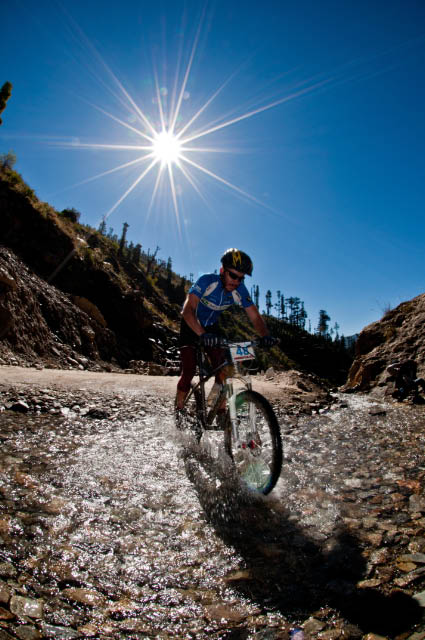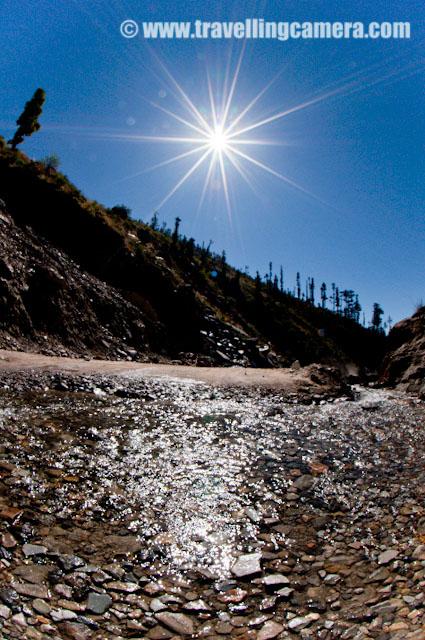Long time back I attended an exhibition on Night Photography by Anindo Ghosh and there was a photograph of India Gate with lot of street lights around and all of them had a unique star effect.. Since then I have been trying to click photographs to get this effect and many times failed to achieve so. I think one easy way to get star effects is to use star filter which helps getting that effect out of light sources... But I never got a chance to use a star filter, although one of my friend offered one... That filter used to create four light streaks which I didn't like.. Over the time I learned few tricks which can work in specific situations and still exploring more such ways !! Check out some of the photographs here ....
 Here is one of the photograph I liked and it was shot during MTB Himachal 2010 near Shimla and idea was to shoot these riders against light and get that star effect in the background.. Now point is how to make it !!! One basic idea to get this effect is bases on simple principle of Aperture.. Smaller the aperture, less light hit the sensor and its equally distributed symmetrically. So if we set small aperture to get effect but off course this technique has some limitations in itself..
Here is one of the photograph I liked and it was shot during MTB Himachal 2010 near Shimla and idea was to shoot these riders against light and get that star effect in the background.. Now point is how to make it !!! One basic idea to get this effect is bases on simple principle of Aperture.. Smaller the aperture, less light hit the sensor and its equally distributed symmetrically. So if we set small aperture to get effect but off course this technique has some limitations in itself...jpg)
Next thing is about shape of this star and its impact on overall photograph.. Off-course, the shape of this star will also be dependent on settings we use and will vary during various time of the day !!!
And if you wonder about the role of lens, it makes a difference !! Its completely on the basis of my experiments, but I observed that any experiments with light sources give different results with various lenses.. I have tried all these with three lenses I have and results were very different : 18-115mm which comes with Nikon D90, Fish Eye and 50 mm... All gives different results and I loved what I got using Fish-Eye lenses, but it doesn't mean that only fish-eye can give these results...
Now next thing which comes into mind is how to good click photographs with smaller aperture? Yes, that is a challenge because every time we can't afford to use slow shutter-speed and its not very practical to use tripod every time. It becomes more challenging when we need to capture some very high speed object with this effect.. In that case light conditions matter a lot... Most of the photographs you see here are taken in Himalayas where light conditions are very good without any pollution and it would be opposite in cities like Delhi !!! so try it out and make your own formulas....
Smaller the Aperture, Beautiful would be the star effect from sun !!!
But yes, one other thing which is very important is to adjust the direction of your lens with respect to location of Sun !! Of course, probability of getting lens-flare increases when we face the lens towards sun, you may notice this thing in few of the photographs above...
Here you see this star effect of sun but lot of noise in the photograph !! As I said, small aperture is key so one needs to adjust Shutter-speed or ISO according to light conditions.. Here ISO was bumped up and that why this noise...
Its a shot around 12:00 noon when sun was really harsh and you see flair in the photograph and I am not sure how can we avoid these... Probably some filter which I don't have :)
A neat star effect but still there is something similar to flair but its not flair... When lens is exposed to such light sources you get to know about the real condition of your lens :) ... These are dust particles which are getting more light attraction while shooting.... So make sure that lens is clean.. This can be seen in very low shutter-speed shots when same spot will get no light and finally a spot at that place !!
Another photograph with star effect out of sun but with flair in the final result !!
India Gate during late evenings @ Delhi (Capital of India)
Here is what I clicked without tripod so had to bump up ISO to capture it well...
Now here you see the difference of lens used... This one is tried with different lens and even tripod was used to shoot at f-24 but results in first one are comparatively better than this one... Hope all these details would help you understand what all I wanted to convey.. Please comments in case you have some other theory around the same or want to have a discussion around the same !!


.jpg)
.jpg)











.jpg)
Comments
am also a big fan of the star effect and rely on the apertures mostly... with some polarizer help during the day... i find two methods really helpful... one, getting only half the glare... so i use the sun on the top corners only till about a quadrant and the photo gets an angle that ways as well... second is tuning the polarizer...
a slight third, i always find noon photographs in monochrome far more telling...
amazing work nevertheless, keep on clicking...:-)...
Ya, you are right. I have tried the same many times and it gives beautiful results !
My "star effect" technique is simple: the smallest aperture the lens can handle, and a stop or two above that, exposure pushed down by a bit (especially in night shots), and different lenses for different "stars" - the lens aperture iris shape is a major factor in the specific type of star you get.
--
Anindo@AnindoGhosh.com
Now I have lot of better shots with star-effect and will try to share sometimes soon :)
Over quality of this shape depends a lot of Lens-Optic.